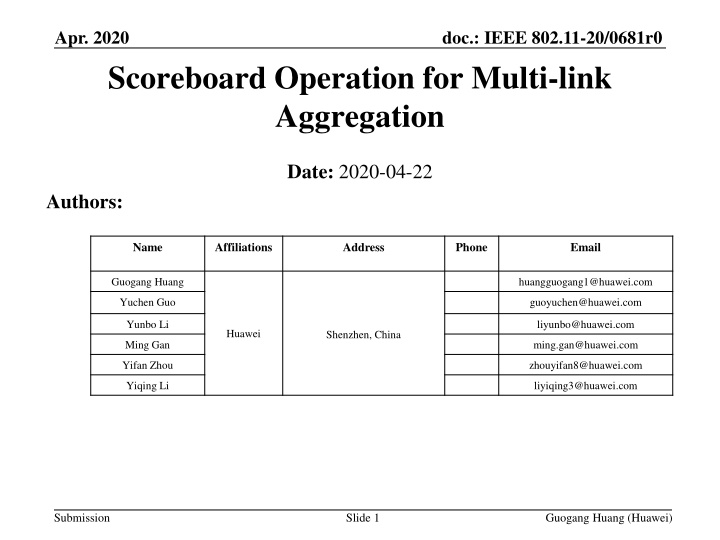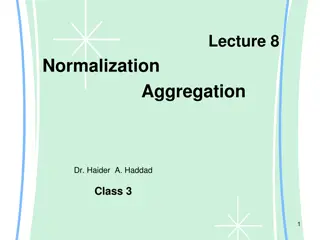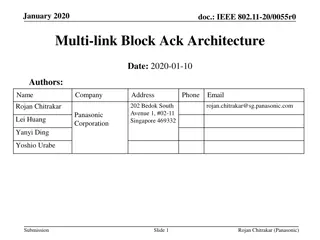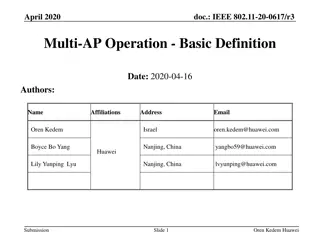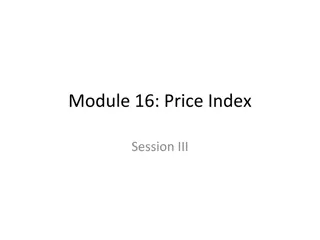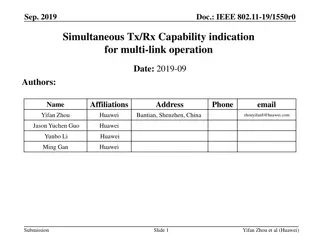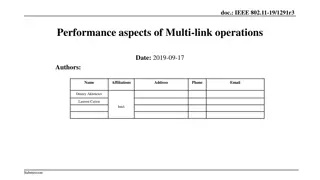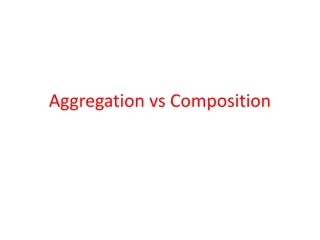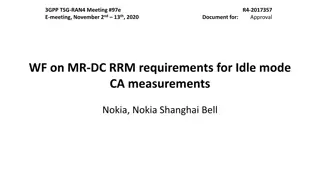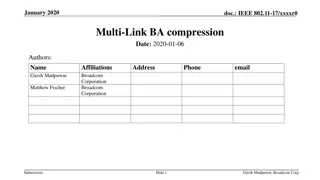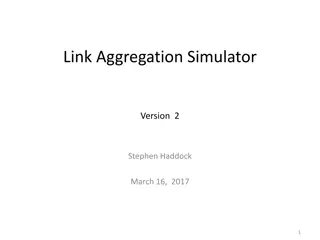Scoreboard Operation for Multi-link Aggregation
"The implementation of scoreboard operation for multi-link aggregation in IEEE 802.11-20/0681r0 document. The proposal aims to enhance TID throughput and reduce transmission delays by managing Sequence Numbers effectively. It introduces a solution to avoid discarding frames and optimize retransmission strategies. Key aspects include rule definitions, shift principles, and window adjustments."
Uploaded on Feb 16, 2025 | 0 Views
Download Presentation

Please find below an Image/Link to download the presentation.
The content on the website is provided AS IS for your information and personal use only. It may not be sold, licensed, or shared on other websites without obtaining consent from the author.If you encounter any issues during the download, it is possible that the publisher has removed the file from their server.
You are allowed to download the files provided on this website for personal or commercial use, subject to the condition that they are used lawfully. All files are the property of their respective owners.
The content on the website is provided AS IS for your information and personal use only. It may not be sold, licensed, or shared on other websites without obtaining consent from the author.
E N D
Presentation Transcript
doc.: IEEE 802.11-20/0681r0 Apr. 2020 Scoreboard Operation for Multi-link Aggregation Date: 2020-04-22 Authors: Name Affiliations Address Phone Email Guogang Huang huangguogang1@huawei.com Yuchen Guo guoyuchen@huawei.com Yunbo Li liyunbo@huawei.com Huawei Shenzhen, China Ming Gan ming.gan@huawei.com Yifan Zhou zhouyifan8@huawei.com Yiqing Li liyiqing3@huawei.com Submission Slide 1 Guogang Huang (Huawei)
doc.: IEEE 802.11-20/0681r0 Apr. 2020 Background Multi-link aggregation is allowed MPDUs belonged to one TID to transmit simultaneously through multiple links Increase the throughput of this TID Reduce the delay of MPDUs belonged to this TID Submission Slide 2 Guogang Huang (Huawei)
doc.: IEEE 802.11-20/0681r0 Apr. 2020 Motivation When the initiator transmits a BAR to the recipient, if there are MSDUs/A-MSDUs whose Sequence Number values are less than the value in Block ACK Start Sequence Control field of the BAR, the recipien will discard these MSUDs/A-MSDUs even they are correctly decoded. In this contribution, we will give a simple but efficient solution to solve this issue Some frames in A-MPDU1 are not received correctly. The retransmission of missed frames in A-MPDU1 is not helpful. The recipient will discard the retransmitted MPDUs in A-MPDU1 because of the adjusted WinStartB. A-MPDU1 (Seq 1 to 31, 60, 61) Link1 BA A-MPDU2 (Seq 32 to 59) BAR Link2 BA BA BA is not received correctly. Adjust WinStartB Submission Slide 3 Guogang Huang (Huawei)
doc.: IEEE 802.11-20/0681r0 Apr. 2020 Existing Solution Contribution [2] had been proposed Add one bit indication info in the BAR frame to indicate whether the initiator of BAR wants the recipient of BAR to shift the WinStartB or not. If the initiator transmits a BAR to the recipient, the initiator shall guarantee that all the MSDUs/A-MSDUs whose Sequence Number values are less than the value in Block ACK Start Sequence Control field of the BAR will not be transmitted after the BAR. In other words, the initiator shall guarantee that there is no MSDU/A- MSDU whose Sequence Number value is less than the value in Block ACK Start Sequence Control field of the BAR Submission Slide 4 Guogang Huang (Huawei)
doc.: IEEE 802.11-20/0681r0 Apr. 2020 Recap Scoreboard operation Rule 1. The SSN carried in the BAR can be set to the sequence number of the next MSDU to be sent on the link or a sequence number greater than the discarded MSDU Rule 2. Shift rules of scoreboard window When the BAR is received, the recipient shifts the scoreboard to the right so that WinStart = SSN from the BAR and returns a BA frame with the contents of the scoreboard. For each received data frame, If SN is within the current scoreboard window, i.e.WinStart SN WinEnd, then the scoreboard records receipt at the offset represented by SN. If SN is outside the current scoreboard window, but within half sequence space range, i.e. WinEnd < SN < WinStart + 2^11, then the scoreboard is shifted right to accommodate SN, i.e. set the starting serial number of the current window of the scoreboard to WinStart = SN-WinSize + 1. If SN is more than half the sequence space beyond the window, i.e. WinStart + 2^11 <SN < WinStart, then no change is made. Submission Slide 5 Guogang Huang (Huawei)
doc.: IEEE 802.11-20/0681r0 Apr. 2020 Scoreboard Operation for MLA Rule 1. The SSN carried in the BAR sent on each aggregated link can be set to the sequence number of the next MSDU to be sent on the link or a sequence number greater than the discarded MSDU Rule 2. Delayed shift rules of scoreboard window. SSN_i is denoted as the latest SSN value of aggregated link i, which is initialized to the Starting Sequence Number subfield value carried in the ADDBA Request/Response frames. When received a BAR frame on link i, then update the SSN_i to SSN carried in the BAR frame When the BAR is received, the recipient shifts the scoreboard to the right so that WinStart = min(SSN_1,SSN_2, , SSN_N) and returns a BA frame with the contents of the scoreboard. Submission Slide 6 Guogang Huang (Huawei)
doc.: IEEE 802.11-20/0681r0 Apr. 2020 Scoreboard Operation for MLA Rule 2. (Cont.) For each received data frame, If SN is within the current scoreboard window, i.e.WinStart SN WinEnd, then the scoreboard records receipt at the offset represented by SN. If SN is outside the current scoreboard window, but within half sequence space range, i.e. WinEnd < SN < WinStart + 2^11, then the scoreboard is shifted right to accommodate SN, i.e. set the starting serial number of the current window of the scoreboard to WinStart = SN-WinSize + 1. If SSN_i<WinStart, then SSN_i is updated to WinStart, i=1,2, ,N If SN is more than half the sequence space beyond the window, i.e. WinStart + 2^11 <SN < WinStart, then no change is made. Submission Slide 7 Guogang Huang (Huawei)
doc.: IEEE 802.11-20/0681r0 Apr. 2020 Example 1-Delayed shift For simplicity, we make the following assumption ACK Policy field of all QoS data frames are set to Block ACK There is no case where SN falls on WinEnd <SN <WinStart + 2 ^ 11 When BAR is received SSN_1=45 SSN_2=30 SSN_2=40 SSN_1=28 SSN_1=25 SSN_1=20 t2 t3 t4 t0 t1 t5 t6 Time WinStart=SSN_0 SSN_1=SSN_0 SSN_2=SSN_0 WinStart=0 min(SSN_1,SSN_2) =min(20,0) WinStart=40 min(SSN_1,SSN_2) =min(45,40) WinStart=20 min(SSN_1,SSN_2) =min(20,30) WinStart=28 min(SSN_1,SSN_2) =min(28,40) WinStart=25 min(SSN_1,SSN_2) =min(25,30) WinStart=28 min(SSN_1,SSN_2) =min(28,30) At the initial time t0, both SSN_1 and SSN_2 are initialized to SSN_0, where SSN_0 is the starting sequence number carried in the ADDBA request and ADDBA response frame, and SSN_1 and SSN_2 are the BAR received on Aggregate Link 1 and Aggregate Link 2, respectively The SSN value carried in the frame. Then the receiver sets WinStart to min (SSN_1, SSN_2) = min (0,0) = 0 At time t1, the receiving end receives a BAR frame on aggregation link 1, which carries SSN_1 of 20, and then the receiving end sets WinStart to min (SSN_1, SSN_2) = min (20,0) = 0 At time t2, the receiving end receives a BAR frame on aggregated link 2, which carries SSN_2 of 30, and then the receiving end sets WinStart to min (SSN_1, SSN_2) = min (20,30) = 20 At time t3, the receiving end receives a BAR frame on aggregated link 1, which carries SSN_1 of 25, and then the receiving end sets WinStart to min (SSN_1, SSN_2) = min (25,30) = 25 At time t4, the receiving end receives a BAR frame on aggregated link 1, which carries SSN_1 of 28, and then the receiving end sets WinStart to min (SSN_1, SSN_2) = min (28,30) = 28 At time t5, the receiving end receives a BAR frame on aggregated link 2, which carries SSN_2 of 40, and then the receiving end sets WinStart to min (SSN_1, SSN_2) = min (28,40) = 28 At time t6, the receiving end receives a BAR frame on aggregated link 1, which carries SSN_1 of 45, and then the receiving end sets WinStart to min (SSN_1, SSN_2) = min (45,40) = 40 And so on Submission Slide 8 Guogang Huang (Huawei)
doc.: IEEE 802.11-20/0681r0 Apr. 2020 Example 2-Delayed shift Sequence Number Space 4 103 SSN_1=0, SSN_2=0, WinStart=4 Since SSN_1<WinStart, SSN_2<WinStart, then SSN_1=4, SSN_2=4 1 WinSize=100 4 103 SSN_2=20 WinStart=min(SSN_1,SSN_2) =min(4,20) 1 6 103 105 SSN_1=4,SSN_2=20, WinStart=6, Since SSN_1<WinStart, SSN_2>WinStart, then SSN_1=6 1 1 105 6 103 Within the Scoreboard window, then no change is mad 1 1 10 109 SSN_1=10, WinStart=min(SSN_1,SSN_2) =min(10,20) Submission Slide 9 Guogang Huang (Huawei)
doc.: IEEE 802.11-20/0681r0 Apr. 2020 Discussions Advantages of proposed solution There is no requirement for interaction capability between aggregated links at the transmitter side, which is very useful especially for non-collocated MLA No need to change the existing BAR frame format and sending rules at the transmitter side, just change the shift rule of WinStart at the receiver side Submission Slide 10 Guogang Huang (Huawei)
doc.: IEEE 802.11-20/0681r0 Apr. 2020 Summary In this contribution, we proposed a method of scoreboard operation for multi-link aggregation. Submission Slide 11 Guogang Huang (Huawei)
doc.: IEEE 802.11-20/0681r0 Apr. 2020 Reference [1] 11-20-0122-01-00be-a-bar-variant-for-multi-link-operation [2] 11-19-1856-03-00be-a-mpdu-and-ba Submission Slide 12 Guogang Huang (Huawei)
doc.: IEEE 802.11-20/0681r0 Apr. 2020 Straw Poll 1 Do you agree that the proposed shift rules of scoreboard window for multi-link aggregation? Yes No Abstain Submission Slide 13 Guogang Huang (Huawei)
